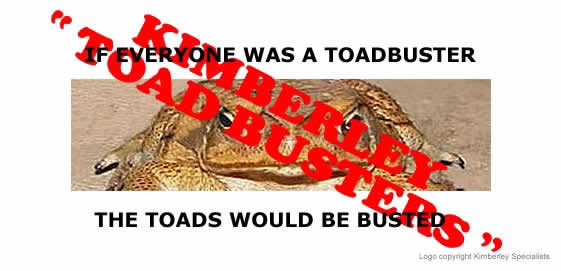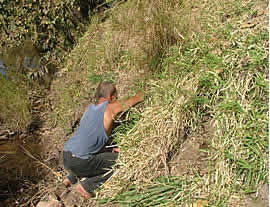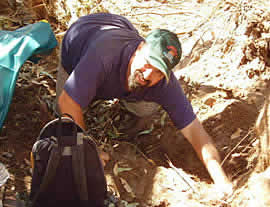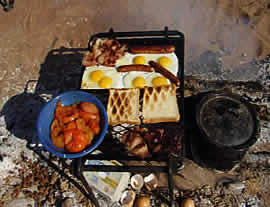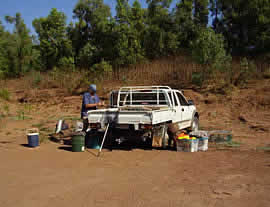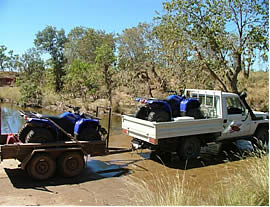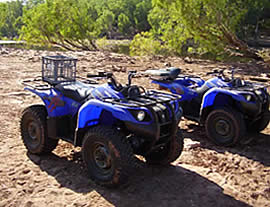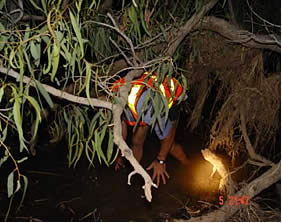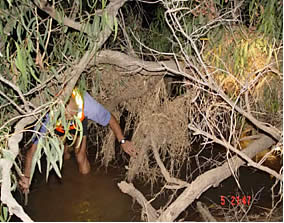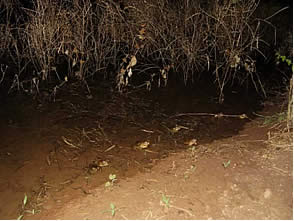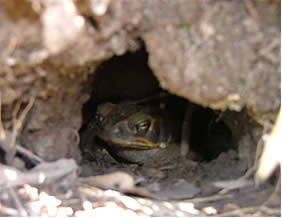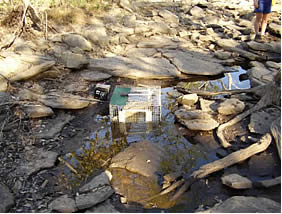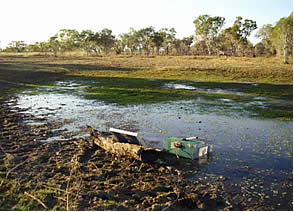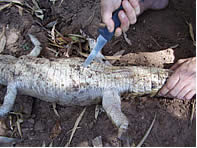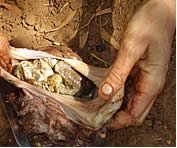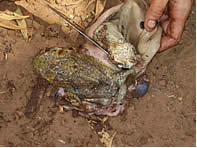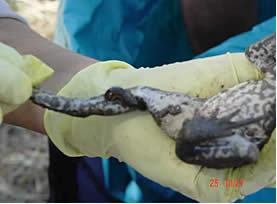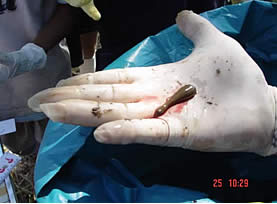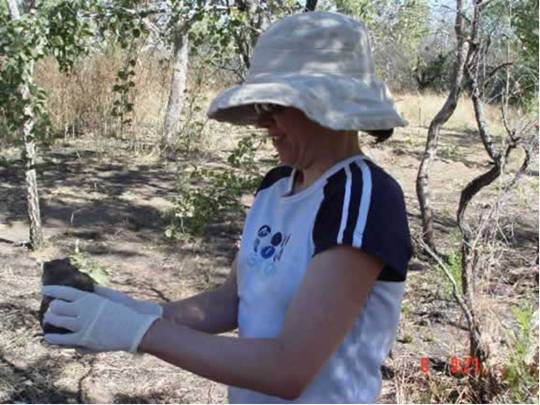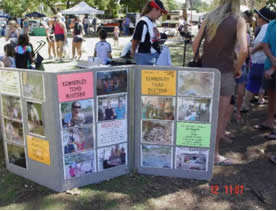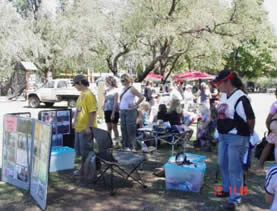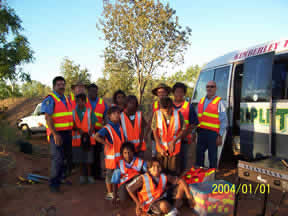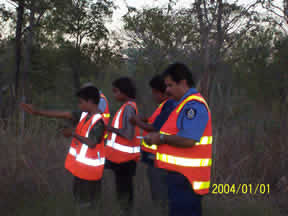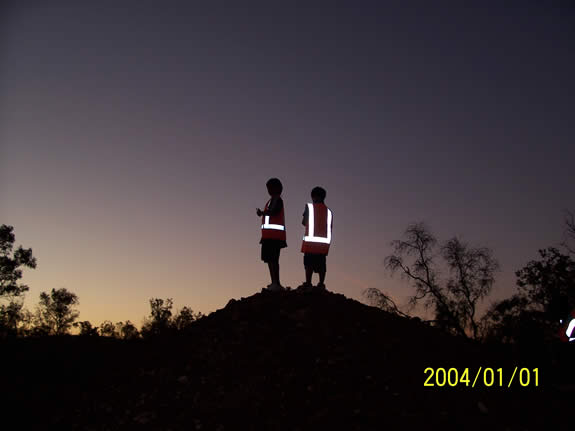A heartfelt cry from the Kununurra Community to the Nation. We will Stop the Cane Toads getting into WA! |
 |
 |
 |
 |
 |
|---|
KIMBERLEY SPECIALISTS Volunteer CANE TOAD Training & Toad Busting NEWSLETTER No.15
WWW.CANE TOADS.COM.AU The Cane Toad is a Key Threatening Process to the Australian Nation. Federal Government 12 April 2005 Newsflash!
Donated by Lovell Diversion Gallery, ticket sales raised $10,000 for the Kimberley Toad Buster volunteers. Margo and Roger intend to launch the painting at a Rotary Function to raise additional funds for the Kimberley Toad Busters.
|
An Update on the Kimberley Toad Busters.
They say a photograph can say a thousand words. Toad busting photographs definitely say it all.
Chris Shaw and Dave Cugley busting toads at Wickam Point on the Victoria River . And you think ‘busting’ toads is easy? Photo’s: Courtesy Dave Woods.
Typical Kimberley Toad Busters breakfast! Mike Shaw setting up camp for the night! So not all hard work Photo’s Dave Wood.
The KTB’s quad bikes and the 4W/D Trayback purchased from Federal funding grant. Photo Dave Woods Photo Dean Goodgame.
Toad Busting at Brownies Creek took on a whole new meaning for Trevor Dutoit. The toads soon found out that swimming for ‘shelter’ was useless. Almost 300 toads were picked up by our diligent teams during the night. Photo’s Dean Goodgame. “ Kimberley Toad Buster volunteershave been so busy toad busting and working out how to ‘manage’ the flood movements of toads since the wet that there has been little time to produce the number of up-dates and Newsletters that we would like. With our dry season trapping and field strategy now in place, it has also meant a lot more time in the field. Unfortunately it also means that when we finally manage to produce a Newsletter it becomes rather a long one. Dean Goodgame has begun to restructure our cane toad website www.canetoads.com.au so that a lot of the team reports and other information can be loaded directly onto the site. This will take the pressure off needing to produce long Newsletters to get all our information out there. While the extent of the wet season movement of toads as far west as the Baines River system (recently located by the Department of Environment and Conservation team) and south on Victoria River Downs (located by the Kimberley Toad Busting team) has been disappointing the finds were not unexpected. In a paper presented at the Brisbane Conference by KTB volunteer and Perth Based Friends of the Kimberley Toad Busters, Sandra Boulter some months ago, we had already acknowledged that it was possible we were going to find flood movement of toads as far as the Baines and south to Victoria River Downs. This has now been verified. We (the KTB) are still confident that concentrated ‘busting’ and trapping will ‘mop’ up these worry areas before this next wet season. We will however, also continue to ‘bust’ areas behind the front line to mitigate the impact of new ‘waves’ of toads coming through. It seems pointless (and certainly not sustainable) to do nothing about major breeding ‘waves’ of cane toads then hitting the incursion areas. Getting Aboriginal Communities and Station owners to help in the quest to ‘toad bust’ has been a priority in our ‘educational’ strategy. If we can get these groups behind the ‘new incursion’ and ‘front-line’ areas to ‘toad bust’ there is a very real chance that we can hold and possibly ‘move’ the front line back. We desperately need to buy time (for the Kimberley biodiversity) for our scientists to come up with a biological method of control. Our toad busting count as of last weekend has now bought our tally to 19,833 cane toads removed by Kimberley Toad Buster volunteers from the system since the 10 th September 2005”. If we work on a quarter of these (And it is closer to 43%) being large female’s capable of producing 70,000 eggs a year, we have taken out three hundred and forty seven million, seventy seven thousand, five hundred potential eggs from the system”. This does not even take into consideration the tens of thousands of metamorphs, tadpoles and eggs also removed from the ‘front’ by the KTB. Toads ‘evolving’ in a single generation? A scary thought! But is it happening? When KTB first started toad busting we were given information such as
There were also lots of grey areas in the general information on the toxin, how cane toad tadpoles behave, how to identify cane toad juveniles, where to find eggs, colonising males, what represents a ‘front’ etc etc. Our KTB were soon to learn that in actual fact little was really known about the behavioural patterns of cane toads (despite 70 years since their introduction into Australia ). We were also to learn that no-one had ever worked at the front line as consistently as the KTB and (initially Ag. WA) and the Department Environment and Conservation. KTB and DEC have now worked for a full year at the cane toad front. We (KTB) have since learnt that
Weekend Toad Busting! How useful has it been? It has been interesting to note the recent Perth debate on one night of toad busting by volunteers verses three to four in a row. While it can never be disputed that toad busting consecutive nights in the one area has to produce good results, this would need to be continued month after month. The problem with working at the cane toad front line is that each new incursion area is subjected to wave after wave of cane toads coming from behind. This is one of the reasons KTB also continue to bust behind the new toad incursion fronts. It must also be pointed out that KTB have ‘toad busted’ (with the exception of 5 wet season weekends) every weekend since the 10 th of September 2005 . They have also undertaken the occasional longer bust of up to 6 consecutive days (the Christmas bust being one of these). They bust with multiple teams, work each area several times in a night, and often work with large teams averaging 15 people (particularly over the wet season). KTB have in fact had up to 90 people on a single bust. It must also be noted that the Department of Environment and Conservation have also had a team in the field on a weekly basis for up to three nights and four days. KTB liaise with DEC and often work their field strategy to direct people into the same areas DEC have spent the week in. This has meant that the KTB and DEC have actually consistently toad busted the same areas month after month. The consecutive ‘night’ busting argument sounds good but unless consistent holds little real argument. Furthermore KTB had not only worked one night (and often well into the early dawn) but toad bust, check water holes, undertakes field reconnaissance over the two days of the weekend. The field results of almost a year of consistent toad busting speaks for itself. Dry Season Field Work Strategy! The past several weeks of toad busting by the volunteer Kimberley Toad Busters has produced a few surprises. Unlike the wet season strategy, toad busting during the dry is proving to be more efficient with small teams of 4 to 6 people busting designated areas. This is enabling us to move small self sufficient and experienced teams of people into various incursion areas to 'mop' up any of the isolated new finds as well as continuing to deal with the major cane toad front lines identified along the Victoria River during the wet season. The addition of the Quad bikes and Toyota tray back made available through Federal Government Funding have proven to be invaluable in getting into vehicle restricted areas. KTB teams will continue to ‘bust’ toads in the Victoria River Station section of the Buchanan Highway and reconnaissance trips by Dave Woods and his team over the next couple of weekends will hopefully confirm the full extent of the wet season movement of toads in this area ( see our website www.canetoads.com.au for copies of the field reports). We will then focus more teams in this area. Maryanne Winton, one of our KTB Aboriginal Coordinators is currently talking with Traditional owners of country between the cane toad front and the WA border. Maryanne is also actively organising a full Toad Busting Educational Exercise to take place at the Yarralin Aboriginal community. Four other Communities from the general area will be involved. Time is not however, on our side, unless our teams can move quickly. A recent increase in temperature and humidity has meant the toads have begun to move away from water again. Males have started to call and we are finding increased evidence of amplexing toads. Tadpoles and metamorph activity is also more evident. To counteract this unexpected ‘movement’ of toads we have increased the number of teams going into the field each weekend and are ‘busting’ several different areas at once. We have teams going into the field in September for up to 10 days at a time. It is hoped that such concentrated and focussed ‘toad busting’ will eliminate breeding populations of toads in all the areas of concern.
Recent warm weather has increased toad activity. Photographs curtesy Dave Woods. Dry Season Trapping Strategy! We have begun a trapping strategy in all the risk areas south and north of the Victoria Highway and east and west of the Buchanan Highway . The traps are being placed in any water system that has indicated toad activity. This will continue to be followed up with night toad busting on a frequent basis. Several exercises of up to 10 days are planned, with the Conservation Volunteers Australia joining in partnership with our Kimberley Toad Busters for 10 days in September. We hope, with the help of CVA and other volunteer groups to have 60 traps placed in the field by mid September. The Kimberley TAFE Kununurra CDEP and KTB facilitated trap making and Ranger Training team, under the leadership of Chris Spur will spend two nights and three days in the field placing traps and checking those already in place. It is planned to have the CDEP Ranger Training team undertake this activity on three occasions during the course. It is this additional back-up to other volunteer activities undertaken by the KTB that help to make this volunteer activity one of the best and most efficient ever seen in Australia. Traditional Aboriginal owners have been consulted by our Aboriginal volunteer co-ordinators about any areas that may be sensitive. Where KTB can we have attempted to involve Aboriginal Traditional Owners in assisting and being involved in ‘toad busting’ areas where their traditional food supplies are now at risk. All Aboriginal Communities consulted have expressed an interest in being involved in the trapping program. Maryanne Winton (KTB Aboriginal coordinator) is facilitating and managing the placement of traps in communities located east of the Duncan Highway (between the cane toad front line and the Western Australian border). Maryanne is also organising a KTB trap making program in one of the communities. KTB will help facilitate this program and provide the materials required to make the traps. Once this is in place KTB will have traps supplied from three local sources.
Traps are being placed in the water. Photo’s curtesy Dean Goodgame. Kimberley Toad Busters continue to record behavioural and other field data: Kimberley Toad Busters continue to record all relevant behavioural and other ‘incidental’ date while in the field working at the cane toad front. The observational data recorded by Desanka Mijovic go a long way towards helping those scientists questioning why fresh water crocs are susceptible and salt water crocs do not appear to be so? (or have we missed something?). The Leeches and ticks that KTB are finding on toads are also raising puzzling questions? Why do they not appear to be effected by cane toad poison? Why is it that the Lavender Beetle is sometimes ‘toxic’ to the cane toad and sometimes not? On the results of almost twelve months of continuous toad busting and the recording of field data that has not been recorded in the 71 years since the cane toad was introduced into Australia, KTB are finding major inconsistencies in the information that has been released to the general public and that being released by the so called ‘experts’ and scientists working in the field. Much of this information is in our Newsletters, however a more formal report outlining the results of the last twelve months volunteer toad busting and recorded field results is currently being compiled by Adrienne Meredith, our KTB Research Officer. KTB have also began trailing new data sheets put out by the Department of Environment and Conservation. Although KTB have their own data sheets they continue to fill in data forms provided by DEC. This working relationship is producing an enormous range of cane toad behavioural and other research information.
Dejenka autopsing a dead fresh water croc. Two toads removed from the stomach! Photo’s Dave Woods.
Leeches attached to toads. Photo’s Dean Goodgame. Conservation Australia Volunteers. Conservation Australia Volunteers have joined in partnership with Kimberley Toad Busters to try and ‘bust’ new wet season front line incursions a well as assist us with our dry season trapping program. Conservation Australia Volunteers will spend 10 days in the field (along with some of our trained toad buster leaders who will begin with an educational field training exercise) to work on some of the main areas of concern. This is great news for the KTB who work every weekend at the cane toad front areas but need more groups (that can) to work longer periods of time in the field. Perth Friends of the Kimberley Toad Busters! The Friends of the Kimberley Toad Busters are a Perth based If anyone is traveling to Kununurra and would like to go The Friends also assist the KTB with administrative and scientific support The Friends’ efforts are our contribution to keeping the cane toads at bay at the Victoria River system in the Northern Territory until a solution to this national threat to our biodiversity is found. If you would like the Friends to come and talk to your organisation The Friends of the KTB are all volunteers and we welcome the assistance of anyone who is dedicated to supporting the front line unique community campaign of the wonderful Kimberley Toad Busters.
Elouise Dortch, a well known West Australian Journalist joins KTB for a weekend toad bust! Marion Winton/ Aboriginal Community Training Course. Kimberley Toad Buster Cane Toad Education Officers are going out to Yarralin Aboriginal Community to run a full cane toad educational Cane Toad Training session. Marianne Winton, one of the Kimberley Toad Busters Aboriginal coordinators is facilitating and organizing this training session. Four other Aboriginal Communities will be involved. RB Junction, Mistake Creek, Dharlu and Brumby Plains. This will be the second major cane toad educational program run by the Kimberley Toad Busters in the Northern Territory . A similar exercise, facilitated by Timber Creek Aboriginal elder Elaine Watts was run in December 2005 at the Fitzroy Community. Elaine Watts and 6 of her young girls are now very active in training and running toad busts in and around Timber Creek. Elaine has been very helpful in assisting KTB in making contact with Traditional owners. Paddy’s Market Cane Toad Educational Display. Sharon McLachlan, with the occasional helper has been running a Cane Toad educational photographic display each Saturday morning for the past three months. Located at White Gum Park , this has been an excellent venue to promote cane toad awareness to both locals and visitors to the area. The photographic display of Kimberley Toad Busters in the field has particularly been a great hit with our young Junior’s. This venue has also been used to promote our membership drive and over a thousand members of our community have now registered as Kimberley Toad Busters, both to help in the field and to assist in promoting the KTB cane toad education and awareness program throughout the Kimberley . DEC have provided literature and jars of toad specimens for the display. The ‘real’ toads in the jars proved to be a real attraction for the general public.
Sharon Mclachlan’s Educational display at Paddy’s Markets. Photo’s Dean Goodgame: Kimberley Toad Busters Shire of Wyndham East Kimberley presentation. Sarah Brett, our Kimberley Toad Busters Education Officer will present a Power Point Presentation to our Wyndham East Kimberley Shire Councilors on the 5 th September as part of the Kimberley Toad Busters cane toad awareness campaign. Sarah will outline some of the proactive cane toad awareness strategies the Shire can become involved in to assist our community in delaying the arrival and on various strategies that can be implemented to ensure the cane toad has minimal impact when it arrives (hopefully the KTB efforts will put this back a few years?). Kimberley TAFE, Kununurra Cane Toad Ranger Program (A Kimberley Specialists in Research Inc, Kimberley Toad Busters Inc and Kimberley TAFE initiative and funded by Biodiversity Protection Inc & Triple J Tours). a) Kimberley TAFE, Kununurra has commenced its second accredited Training program in cane toad control. This course is recognized as a Certificate I, Conservation & Land Management (Vertebrate Pest Management) specializing in cane toad control. This course is being run for CDEP participants and 10 local Kununurra mob have so far enrolled. To date participants have been inducted with Safety protocols and toad biology. The mob will participate in their first toad bust in a fortnight’s time. This toad bust will occur through the week and complement the weekend busting by the Kimberley Toad Busters. The group will aim to deploy many more traps in hot spots, maintain and clear existing traps and complete an overnight toad muster. There are three toad bust exercises planned as part of this course. The course participants will develop their skills in all aspect of toad busting such as: Navigation, safety procedures, trapping design, construction and maintenance, toad identification, ecological concepts, common sense in remote areas and maintenance and servicing of basic machinery. The course is designed to give participants broad knowledge and skills in basic ranger practice with an emphasis on cane toad control. Successful participants will be able to transfer the skills gained in this program into other areas that they may so wish. There are also opportunities for participants to act as Kimberley Toad Buster leaders. b) Cane Toad Trap Building Course at Wyndham Work Camp (A Kimberley Toad Busters Inc and Kimberley TAFE initiative, in partnership with Warangarri CDEP, and funded by Biodiversity Protection Inc & Triple J Tours) As part of Kimberley TAFE’s commitment to the Kimberley Toad Busters cane toad trap building is set to continue as part of a training program at the Wyndham work camp. The participants will learn skills in metal fabrication and electrical wiring. The result being traps built to Kimberley Toad Busters specifications complete with deep cycle batteries and solar panel re-chargers. The traps will then be utilized by Kimberley Toad Busters and the work camp crew themselves. The work camp participants will set up sentinel traps and monitoring stations throughout wetland systems around Wyndham, including the Parry lagoons area. Here they will learn all the skills necessary to become a toad buster and trial new data recording methods, trapping strategies and trap designs. The course is set to commence in early September and will continue indefinitely. For queries please ring Chris Spurr Kimberley TAFE Kununurra, on 9168 0833 Or Ronnie Atkins, Warangarri Aboriginal Corporation CDEP 08 91681528 Warangarri Aboriginal Corporation CDEP Cane Toad Educational Training Night. Ronnie Atkins, one of our Kimberley Toad Buster Leaders and Waringarri CDEP coordinator is organizing a full cane toad educational training night to be held in Kununurra. The training course will be facilitated by Kimberley Toad Busters. A number of our KTB education officers will be presenting on the night. The date for this evening will be advertised on our community cane toad website www.canetoads.com.au, in our next KTB Newsletter and in the local paper, The Kimberley Echo. St Josephs students perform at the Wakakirri National Story Festival. 50 students from our local St Joseph’s Kununurra school, aged between 6 and 13 performed in Perth in August, telling the story of the cane toad’s imminent arrival in Kununurra. 3 gold awards and 3 silver awards were presented, winning them a place a one of 5 state finalists and a chance to compete at the Perth Concert Hall on the 20 th September. If they win the WA state title they will go on then to compete for the National prize. Kimberley Toad Busters Educational Training Officer Sarah Brett will present the performers with an up-date on our community volunteer activities in the field on Monday 11 th September 1-2pm at Field Reports from Our Kimberley Toad Busting Teams! Field reports are provided by each Kimberley Toad Busters team that works in any designated ‘cane toad threat’ area (these are accompanied with the data sheets each group is required to fill out). While decisions on how to ‘work’ each designated toad busting area is left to the Team leaders of each group, the results of the ‘toad busts’ are recorded on various data sheets designed to register as much information as we possibly can. The Kimberley Toad Busters use both data forms provided by the Department of Environment and Conservation as well as those devised by our Research Officer Ade Meredith. Input from Research Scientists interested in ‘front-line’ cane toad observations on environmental and behavioral data has also been added to our data sheets. We would love to put all the field reports into our Newsletters as they provide a real ‘feeling of being there’, however this would mean a Newsletter of over a hundred pages. All the field reports received over the past twelve months are currently being loaded onto our website www.canetoads.com.au . Biological Specimens and Government Red Tape! At present the Kimberley Toad Busters cannot bring toads (dead or alive) into WA. In the interest of Biological Research this situation is not a particularly tenable one. Recent discoveries by Kimberley Toad Busters of leeches and tics surviving, despite being attached to the cane toads, may provide a new research answer to a biological solution to the cane toad. Whether this proves to be the case, it is imperative that these specimens reach scientists working on biological solutions. Current Western Australian government policy does not allow KTB to bring toads (dead or alive) across the border. It has been jokingly mentioned several times that if we wait long enough we will be able to pick up ‘live’ toads from our own back doorsteps. We are, in the interim, hoping to attain permits that will allow our KTB to bring dead specimens across the border. Cane Toads; The Quarantine Inspection Check Point and Tourists! ‘and other issues’. Despite the fact that 71 years have now passed since the introduction of cane toads into Australia and that it is now a very real fact that cane toads are perhaps only one more wet season away from crossing into Western Australia (but not if the Kimberley Toad Busters have anything to say about it) our Western Australian Quarantine Check Point and the Western Australian Government is ill prepared to handle the situation. On the one hand enormous resources are being pushed into cane toad awareness but little has been done to work out how visitors traveling into Western Australia from the Northern Territory and toad busting on the way (as encouraged) are to dispose of these pests. Kimberley Toad Busters cannot bring live toads to the check point. What of other concerned travelers ‘trying’ to do their bit? In the Northern Territory , conflicting legislation on the feral status of the cane toad has resulted in the NT National Parks and Wildlife threatening to prosecute tour operators killing toads in National Parks. After the knowledge of the impact and decimation of the toad on native wildlife in Kakadu National Park this is an appalling situation. It is also a difficult situation for NT Parks and Wildlife Rangers who are attempting to deal with toad infestation in their parks and have no direct funding or straight forward legislative powers to deal with the problem. The KTB would like to see cane toad monitoring/quarantine stations set up at the junction of the Duncan/Victoria Hwy , the junction of the Buchanan and Victoria Hwy and the junction of the Victoria Hwy and Buntine. An additional monitoring station should also be set up at the junction of the Buntine and Duncan. These quarantine/monitoring ‘stations’ (many of whom could provide employment for Aboriginal individuals living on Communities close to these points) would go a long way towards preventing toads from ‘hitch-hiking and would also provide ‘dropping –off’ points for travelers picking up toads. They could also become central cane toad education ‘centers’. This would also ensure that all ‘toads’ picked up were indeed toads and not some of our ‘long-suffering’ Burrowing Toads. Kimberley Toad Busters would urge the Federal and Western Australian Government to deal with some of the issues of legislation. We would also urge that more resources be put towards funding any Biological Research program that even looks as if it is working towards a solution to the cane toad problem. Community Support! Community support for the Kimberley Toad Busting volunteer activities into the Northern Territory continues to gain momentum. Our membership base has exceeded well over a thousand. Now with the establishment of the Broome based Kimberley Toad busters and the Perth based Friends of the Kimberley Toad Busters we expect to have a membership base of over two thousand by Christmas. A very special thanks needs to go to Triple J for their continued support (well exceeding the ‘call of duty’), The Shire of Wyndham East Kimberley, Rogers Machinery, Lovell Diversion Gallery, Kimberley Specialists in Research Inc, Wildlife Rescue Inc, Kimberley Vet Centre and Alligator Airways. New Community Business Supporters are Bush Camp Supplies who recently contributed camping equipment. And to Tom and Dom Breig who have recently contributed enough food supplies for several toad busts. We have attempted to record all those people who have contributed towards making the KTB volunteer program the successes it has been. We apologise to anyone we may have inadvertently left off our thank you list. Please send us an email of reminder kimberleyspecialists@westnet.com.au Without a doubt, it should also be said that if we did not have the enormous support of the unpaid Board members of the Kimberley Toad Busters, and the many volunteers who give their time ‘also beyond the call of duty’ the cane toads would have arrived in the Kimberley unannounced, just as they have everywhere else in the North of Australia. The Federal Governments Support and what this means to the Kimberley Toad Buster’s! The recent grant of an additional $224,000 on top of the initial $79,000 from the Federal Minister for the Environment, Ian Campbell, has been a ‘Godsend’ to the Kimberley Toad Busters. The Quad bikes have, over the past four weeks, enabled some of our more experienced toad buster leaders to move into isolated and extremely rugged areas quite quickly. Reconnaissance trips, often taking several weeks of doing ‘bits’ at a time have now been completed in half the time. New cane toad incursions located in the Victoria River Station area of the Buchanan Highway have now been GPS’d, and a trapping and field program put in place. Funding for fuel and food and other basic incidental costs is still being largely met by Biodiversity Protection. This commercial fund raising group is still also meeting costs for field and safety equipment. The Friends of the Kimberley Toad Busters is also very pro-active in raising funds from the community in general. This helps to cover unexpected toad busting field expenses. Not one single dollar raised from the community goes towards administrative costs. All KTB remain unpaid volunteers. The Kimberley Toad Busters Bob Cooper Junior Bush Survival Skills Course.
Young Men’s Program participants on the Bob Cooper Bush Skills Training Course. Photo’s courtesy Pedro.
The recent Junior Toad Busting Bob Cooper Bush Survival Skills Certificate Course was an outstanding success, with over 100 young Indigenous and non Indigenous individuals aged between 10 and 20 participating over five nights. Sponsored by Kimberley Toad Busters Inc. the Bush Skills and Survival Course were aimed at making our volunteer toad busting safer for our Junior Toad Busters. Emphasis was placed on how to work in pairs and as a team, how to work safely in an environment that has crocodiles, buffalo and wild pigs, what to do when lost, what to do in an emergency such as a snake bite or injury and how to navigate by the stars. Bob Cooper also included general discussions on environmental concerns and some of the actions our young toad busters could undertake to help preserve our native wild life. While many of our young experienced Junior Toad Busters were involved, the course was also open to individuals who had not yet had the opportunity to come toad busting but wanted to be involved in the future. The CDEP and ‘Young Men’s Programme’ and the Kimberley School of the Air were some of those that participated in the course. The Kimberley Toad Busters intend to facilitate further Bob Cooper Bush Survival skills Courses for both adults and Junior’s in the future. If anyone is interested in participating in future courses please contact Sharon on 0427420191 or Lee on 91682576 or check our website for details. www.canetoads.com.au 3 Day Bob Cooper Survival Course for Kimberley Toad Busters Leaders. Eight Kimberley Toad Busters recently spent three days undertaking a Bush Survival Course under the direction of Bob Cooper. And what an amazing experience it was. I had always prided my self on my bush skills and ability to ‘find’ my way around the bush but I certainly learnt that my education was definitely at around kinder-garden level. However we all passed and can now make fire (and not with matches either), navigate by the stars and the sun and most important of all, make water in the middle of a sandy desert. Georgina and Annie Wilson and Maryanne Winton, three of the KTB Aboriginal toad busting leaders agreed that even they learnt a lot about bush survival skills. The whole course was lots of fun and the competition strong between the Kimberley Toad Busters and the CALM team, but without a doubt we have all come away with a better sense of how to ensure future toad busting exercises undertaken in the NT bush can be made a lot safer. The KTB have decided to incorporate many of the principles we learnt into our toad busting field safety manual. The Kimberley Toad Busters would like to thank CALM for contributing towards half the cost of the course. Without their input we would not have been able to have eight of our toad Buster leaders participate. Department of Environment and Conservation and the Kimberley Toad Busters! A very real and complimentary working relationship between the Department of Environment and Conservation and the Kimberley Toad Busters Community Volunteer force continues to grow. DEC continues to maintain the toad busting fieldwork during the week with the KTB primarily focusing on the weekends (although irregular weekly night toad busting has been undertaken by Kimberley Toad Busters. Kimberley Toad Busters have also ‘busted’ areas up to 6 days at a time). After almost 12 months of continuous toad busting by both teams, this has ensured that at least 4 nights and 6 days of regular toad busting has occurred. Debriefing sessions held on a regular basis has ensured that real cane toad problem areas have been consistently ‘busted’. The ability of Kimberley Toad Busters to pull large teams into the field for a single bust also means that some areas can be busted several times in a night, and by large numbers of people. The success of this working relationship between KTB and DEC is focused on consistent and regular ‘toad busts’ in the same areas, complimentary trapping programme’s, and an ability to ensure that there is no ‘doubling up’ or waste of energy and human resources. “The real strength of this volunteer regional campaign is that it is being planned, directed and coordinated from the local area i.e. Kununurra. We are all part of the effort; every individual has ownership and makes their contribution in close liaison with the KTB Board and KTB field coordinators and with the Department of Environment and Conservation. Any attempt that succeeds in removing any part of the campaign decision making or the field strategy planning away from the Kununurra community groups and the KTBs will result in a loss of ownership felt amongst the campaigners. This is likely to lead to a significant loss of the volunteer energy required for our success. If that happens, the Kimberley ecosystems and the fauna and flora they support are more likely to be diminished and perhaps even lost to this noxious menace”. Amazing Perth volunteer Sandy Boulter who has attended three of the Kimberley Toad Busters field excursions at her own expense and continues to campaign for business and Government to support any research that is looking for a Biological method of control to help eradicate the cane toad. Sandy is a founding member of the Perth based Friends of the Kimberley Toad Busters. Very special thanks must also go to John and Paddy Weaver (founding members of the Friends of the Kimberley Toad Busters and also from Perth ) who have spent many hours campaigning on behalf of the KTB. And to Tim Mitchell of Biodiversity Protection Inc, who continues to raise funds and provide equipment on behalf of the KTB. IF EVERYONE BECAME A TOAD BUSTER. THE TOADS WOULD BE BUSTED! kimberleyspecialists@westnet.com.au Lee or Dean on 91682576 Or contact Sarah Brett 0407691 |

